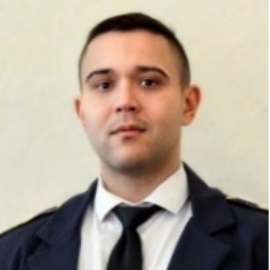International Journal of Computer Network and Information Security (IJCNIS)
IJCNIS Vol. 16, No. 4, 8 Aug. 2024
Cover page and Table of Contents: PDF (size: 1346KB)
Universal On-board Neural Network System for Restoring Information in Case of Helicopter Turboshaft Engine Sensor Failure
PDF (1346KB), PP.65-87
Views: 0 Downloads: 0
Author(s)
Index Terms
Helicopter Turboshaft Engines, Sensor Failure, Automatic Control Systems, Bayesian Neural Networks, Training, Universal Neural Network Diagram, Restoring
Abstract
This work focuses on developing a universal onboard neural network system for restoring information when helicopter turboshaft engine sensors fail. A mathematical task was formulated to determine the occurrence and location of these sensor failures using a multi-class Bayesian classification model that incorporates prior knowledge and updates probabilities with new data. The Bayesian approach was employed for identifying and localizing sensor failures, utilizing a Bayesian neural network with a 4–6–3 structure as the core of the developed system. A training algorithm for the Bayesian neural network was created, which estimates the prior distribution of network parameters through variational approximation, maximizes the evidence lower bound of direct likelihood instead, and updates parameters by calculating gradients of the log-likelihood and evidence lower bound, while adding regularization terms for warnings, distributions, and uncertainty estimates to interpret results. This approach ensures balanced data handling, effective training (achieving nearly 100% accuracy on both training and validation sets), and improved model understanding (with training losses not exceeding 2.5%). An example is provided that demonstrates solving the information restoration task in the event of a gas-generator rotor r.p.m. sensor failure in the TV3-117 helicopter turboshaft engine. The developed onboard neural network system implementing feasibility on a helicopter using the neuro-processor Intel Neural Compute Stick 2 has been analytically proven.
Cite This Paper
Serhii Vladov, Ruslan Yakovliev, Victoria Vysotska, Dmytro Uhryn, Yuriy Ushenko, "Universal On-board Neural Network System for Restoring Information in Case of Helicopter Turboshaft Engine Sensor Failure", International Journal of Computer Network and Information Security(IJCNIS), Vol.16, No.4, pp.65-87, 2024. DOI:10.5815/ijcnis.2024.04.05
Reference
[1]H. Sheng, Q. Chen, J. Li, W. Jiang, Z. Wang, Z. Liu, T. Zhang, and Y. Liu, “Research on dynamic modeling and performance analysis of helicopter turboshaft engine's start-up process”, Aerospace Science and Technology, vol. 106, 106097, 2020. https://doi.org/10.1016/j.ast.2020.106097
[2]N. Trapani, and L. Longo, “Fault Detection and Diagnosis Methods for Sensors Systems: a Scientific Literature Review”, IFAC-PapersOnLine, vol. 56, issue 2, pp. 1253–1263, 2023. https://doi.org/10.1016/j.ifacol.2023.10.1749
[3]A. Yin, Z. Sun, and J. Zhou, “Hypergraph construction using Multi-Sensor for helicopter Tail-Drive system fault diagnosis”, Measurement, vol. 231, 114586, 2024. https://doi.org/10.1016/j.measurement.2024.114586
[4]S. de Gioia, F. Adamo, F. Attivissimo, D. Lotano, and A. Di Nisio, “A design strategy for performance improvement of capacitive sensors for in-flight oil-level monitoring aboard helicopters”, Measurement, vol. 208, 112476, 2023. https://doi.org/10.1016/j.measurement.2023.112476
[5]S.M. Schlanbusch, and J. Zhou, “Adaptive predictor-based control for a helicopter system with input delays: Design and experiments”, Journal of Automation and Intelligence, vol. 3, issue 1, pp. 50–56, 2024. https://doi.org/10.1016/j.jai.2024.02.001
[6]J. Hu, N. Hu, Y. Yang, L. Zhang, and G. Shen, “Nonlinear dynamic modeling and analysis of a helicopter planetary gear set for tooth crack diagnosis”, Measurement, vol. 198, 111347, 2022. https://doi.org/10.1016/j.measurement.2022.111347
[7]K. Sun, A. Yin, and S. Lu, “Domain distribution variation learning via adversarial adaption for helicopter transmission system fault diagnosis”, Mechanical Systems and Signal Processing, vol. 215, 111419, 2024. https://doi.org/10.1016/j.ymssp.2024.111419
[8]S. Vladov, R. Yakovliev, O. Hubachov, K. Mykolenko, S. Drodova, and Y. Stushchanskyi, “Neural Network Method for Helicopters Turboshaft Engines Dynamic Efficiency Monitoring”, in: Proceedings of the 2023 IEEE 4 th KhPI Week on Advanced Technology, Kharkiv, Ukraine, October 02–06, 2023. pp. 160–165. https://doi.org/10.1109/KhPIWeek61412.2023.10312883
[9]M. Kordestani, M. Mousavi, A. Chaibakhsh, M. E. Orchard, K. Khorasani, and M. Saif, “A New Compressor Failure Prognostic Method Using Nonlinear Observers and a Bayesian Algorithm for Heavy-Duty Gas Turbines”, IEEE Sensors Journal, vol. 23, issue 4, pp. 3889–3900, 2023. https://doi.org/10.1109/JSEN.2022.3233585
[10]T. Lu, and S. Hou, “A Two-Layered Malware Detection Model Based on Permission for Android”, in: Proceedings of the 2018 IEEE International Conference on Computer and Communication Engineering Technology (CCET), Beijing, China, August 18–20, 2018. https://doi.org/10.1109/CCET.2018.8542215
[11]X. Zhu, and D. Li, “Robust fault estimation for a 3-DOF helicopter considering actuator saturation”, Mechanical Systems and Signal Processing, vol. 155, 107624, 2021. https://doi.org/10.1016/j.ymssp.2021.107624
[12]J. Lan, R. J. Patton, and E. Punta, “Fault-Tolerant Tracking Control for A 3-DOF Helicopter with Actuator Faults and Saturation”, IFAC-PapersOnLine, vol. 50, issue 1, pp. 5250–5255, 2017. https://doi.org/10.1016/j.ifacol.2017.08.465
[13]J. Y. Yassuda, C. M. Agulhari, and E. R. P. da Silva, “Sampled-data robust control of a 2-DoF helicopter modeled using a quasi-LPV framework”, Control Engineering Practice, vol. 145, 105870, 2024. https://doi.org/10.1016/j.conengprac.2024.105870
[14]W. El Khatiri, R. Cherif, K. El Bikri, and N. Atalla, “Experimental study of component-based transfer path analysis hybrid methods applied to a helicopter”, Applied Acoustics, vol. 210, 109431, 2023. https://doi.org/10.1016/j.apacoust.2023.109431
[15]Z. Gu, Q. Li, S. Pang, W. Zhou, J. Wu, and C. Zhang, “Turbo-shaft engine adaptive neural network control based on nonlinear state space equation”, Chinese Journal of Aeronautics, vol. 37, issue 4, pp. 493–507, 2024. https://doi.org/10.1016/j.cja.2023.08.012
[16]B. Li. and Y.-P. Zhao, “Group reduced kernel extreme learning machine for fault diagnosis of aircraft engine”, Engineering Applications of Artificial Intelligence, vol. 96, 103968, 2020. https://doi.org/10.1016/j.engappai.2020.103968
[17]S. Pang, Q. Li, and B. Ni, “Improved nonlinear MPC for aircraft gas turbine engine based on semi-alternative optimization strategy”, Aerospace Science and Technology, vol. 118, 106983, 2021. https://doi.org/10.1016/j.ast.2021.106983
[18]S. Vladov, Y. Shmelov, and R. Yakovliev, “Modified Method of Identification Potential Defects in Helicopters Turboshaft Engines Units Based on Prediction its Operational Status”, in: Proceedings of the 2022 IEEE 4th International Conference on Modern Electrical and Energy System (MEES), Kremenchuk, Ukraine, October 20–22, 2022, pp. 556–561. https://doi.org/10.1109/MEES58014.2022.10005605
[19]S.S. Talebi, A. Madadi, A.M. Tousi, and M. Kiaee, “Micro Gas Turbine fault detection and isolation with a combination of Artificial Neural Network and off-design performance analysis”, Engineering Applications of Artificial Intelligence, vol. 113, 104900, 2022. https://doi.org/10.1016/j.engappai.2022.104900
[20]S. Vladov, Y. Shmelov, R. Yakovliev, M. Petchenko, and S. Drozdova, “Neural Network Method for Helicopters Turboshaft Engines Working Process Parameters Identification at Flight Modes”, in: Proceedings of the 2022 IEEE 4th International Conference on Modern Electrical and Energy System (MEES), Kremenchuk, Ukraine, October 20–22, 2022, pp. 604–609. https://doi.org/10.1109/MEES58014.2022.10005670
[21]Y. Shen, and K. Khorasani, “Hybrid multi-mode machine learning-based fault diagnosis strategies with application to aircraft gas turbine engines”, Neural Networks, vol. 130, pp. 126–142, 2020. https://doi.org/10.1016/j.neunet.2020.07.001
[22]J. Zeng, and Y. Cheng, “An Ensemble Learning-Based Remaining Useful Life Prediction Method for Aircraft Turbine Engine”, IFAC-PapersOnLine, vol. 53, issue 3, pp. 48–53, 2020. https://doi.org/10.1016/j.ifacol.2020.11.009
[23]V. Vasiliev, S. Zhernakov, and I. Muslukhov, “On-board algorithms for monitoring gas turbine engine parameters based on neural network technology”, Bulletin of USATU, vol. 12, No. 1 (30), pp. 61–74, 2009.
[24]S. Zhernakov, “Algorithms for control and diagnostics of aviation gas turbine engines in the conditions of on-board implementation based on neural network technology”, Bulletin of USATU, vol. 14, No. 3 (38), pp. 42–56, 2010.
[25]S. Vladov, K. Kotliarov, S. Hrybanova, O. Husarova, and L. Chyzhova. “On-board information restoring method in case of failure of one of the sensors of the aircraft engine TV3-117 based on neural network technologies”, Transactions of Kremenchuk Mykhailo Ostrohradskyi National University, issue 6/2019 (119), pp. 91–98, 2019. https://doi.org/10.30929/1995-0519.2019.6.91-98
[26]S. Vasiliev, R. Badamshin, S. Valeev, V. Vasiliev, V. Gvozdev, M. Guzairov, S. Zhernakov, B. Ilyasov, S. Kusimov, R. Munasypov, Y. Raspopov, A. Frid, and L. Chernyakhovskaya, Intelligent control and monitoring systems for gas turbine engines, pp. 327–390, 2008.
[27]O. Dehtiarov, O. Zaporozhets, and T. Ovcharova, “Identification of nonlinear transform function using artificial neural network”, Ukrainian Metrological Journal, no. 2, pp. 4–8, 2013.
[28]X. Liu, Y. Chen, L. Xiong, J. Wang, C. Luo, L. Zhang, and K. Wang, “Intelligent fault diagnosis methods toward gas turbine: A review”, Chinese Journal of Aeronautics, vol. 37, issue 4, pp. 93–120, 2024. https://doi.org/10.1016/j.cja.2023.09.024
[29]J. Bill, B.A. Cox, and L. Champagne, “A comparison of quaternion neural network backpropagation algorithms”, Expert Systems with Applications, vol. 232, 120448, 2023. https://doi.org/10.1016/j.eswa.2023.120448
[30]S. Vladov, R. Yakovliev, O. Hubachov, J. Rud, and Y. Stushchanskyi, “Neural Network Modeling of Helicopters Turboshaft Engines at Flight Modes Using an Approach Based on “Black Box” Models”, CEUR Workshop Proceedings, vol. 3624, pp. 116–135, 2024.
[31]S. Babichev, V. Lytvynenko, J. Skvor, and J. Fiser, “Model of the objective clustering inductive technology of gene expression profiles based on SOTA and DBSCAN clustering algorithms”, Advances in Intelligent Systems and Computing, vol. 689, pp. 21–39, 2018. https://doi.org/10.1007/978-3-319-70581-1\_2
[32]V. Lytvynenko, D. Nikytenko, M. Voronenko, N. Savina, and O. Naumov, “Assessing the Possibility of a Country's Economic Growth Using Dynamic Bayesian Network Models”, in: Proceedings of the 2020 IEEE 15th International Conference on Computer Sciences and Information Technologies (CSIT), Zbarazh, Ukraine, September 23–26, 2020, pp. 36–39. https://doi.org/10.1109/CSIT49958.2020.9321995
[33]M. Voronenko, D. Nikytenko, Jan Krejci, N. Savina, V. Lytvynenko, “Assessing the Possibility of a Country's Economic Growth Using Static Bayesian Network Models”, CEUR Workshop Proceedings, vol. 2608, pp. 462–473, 2020.
[34]M. Impraimakis, “A Kullback–Leibler divergence method for input–system–state identification”, Journal of Sound and Vibration, vol. 569, 117965, 2024. https://doi.org/10.1016/j.jsv.2023.117965
[35]L. Karpukov, V. Voskoboynik, G. Kozina, O. Parshyna, Y. Parshyn, and A. Shapoval, “Pulses Dispersion Distortion Modeling in a Microstrip Line”, in: Proceedings of the 2023 IEEE 18th International Conference on Computer Science and Information Technologies (CSIT), Lviv, Ukraine, October 19–23, 2023. https://doi.org/10.1109/CSIT61576.2023.10324298
[36]J. Li, S. Tong, Z. Tong, H. Li, F. Cong, W. Cheng, and G. Dong, “Investigating the vibration response and modulation mechanism for health monitoring of wind turbine planetary gearboxes using a tribodynamics-based analytical model”, Measurement Science and Technology, vol. 34, number 3, 035119, 2022. https://doi.org/10.1088/1361-6501/aca927
[37]S. Vladov, Y. Shmelov, R. Yakovliev, and M. Petchenko, “Neural Network Method for Parametric Adaptation Helicopters Turboshaft Engines On-Board Automatic Control”, CEUR Workshop Proceedings, vol. 3403, pp. 179–195, 2023.
[38]S. Vladov, R. Yakovliev, O. Hubachov, and J. Rud, “Neuro-Fuzzy System for Detection Fuel Consumption of Helicopters Turboshaft Engines”, CEUR Workshop Proceedings, vol. 3628, pp. 55–72, 2024.
[39]S. Vladov, R. Yakovliev, M.Bulakh, and V. Vysotska, “Neural Network Approximation of Helicopter Turboshaft Engine Parameters for Improved Efficiency”, Energies, vol. 17, issue 9, 2233, 2024. https://doi.org/10.3390/en17092233
[40]S. Vladov, Y. Shmelov, and R. Yakovliev, “Helicopters Aircraft Engines Self-Organizing Neural Network Automatic Control System”, CEUR Workshop Proceedings, vol. 3137, pp. 28–47, 2022. https://doi.org/10.32782/cmis/3137-3
[41]S. Vladov, Y. Shmelov, R. Yakovliev, M. Petchenko, and S. Drozdova, “Helicopters Turboshaft Engines Parameters Identification at Flight Modes Using Neural Networks”, in: Proceedings of the IEEE 17th International Conference on Computer Science and Information Technologies (CSIT), Lviv, Ukraine, November 10–12, 2022, pp. 5–8. https://doi.org/10.1109/CSIT56902.2022.10000444
[42]F.S. Corotto, “Appendix C - The method attributed to Neyman and Pearson”, Wise Use of Null Hypothesis Tests, pp. 179–188, 2023. https://doi.org/10.1016/B978-0-323-95284-2.00012-4
[43]F.V. Motsnyi, “Analysis of Nonparametric and Parametric Criteria for Statistical Hypotheses Testing. Chapter 1. Agreement Criteria of Pearson and Kolmogorov”, Statistics of Ukraine, no. 4’2018 (83), pp. 14–24, 2018. https://doi.org/10.31767/su.4(83)2018.04.02
[44]S. Babichev, J. Krejci, J. Bicanek, and V. Lytvynenko, “Gene expression sequences clustering based on the internal and external clustering quality criteria”, in: Proceedings of the 2017 12th International Scientific and Technical Conference on Computer Sciences and Information Technologies (CSIT), Lviv, Ukraine, September 05–08, 2017. https://doi.org/10.1109/STC-CSIT.2017.8098744
[45]H. Khebbache, M. Tadjine, S. Labiod, and A. Boulkroune. “Adaptive sensor-fault tolerant control for a class of multivariable uncertain nonlinear systems”, ISA Transactions, vol. 55, pp. 100–115, 2015. https://doi.org/10.1016/j.isatra.2014.10.001
[46]Z.B. Shi, T. Liu, and D. Sun, “Reconfiguration for Sensor Failure of Aero-Engine Electronic Control System Based on the MRAC”, Applied Mechanics and Materials, vol. 602–605, pp. 1367–1371, 2014. https://doi.org/10.4028/www.scientific.net/AMM.602-605.1367
[47]S. Vladov, L. Scislo, V. Sokurenko, O. Muzychuk, V.Vysotska, S.Osadchy, and A. Sachenko, “Neural Network Signals Integration from Thermogas-dynamic Parameters Sensors for Helicopters Turboshaft Engines at Flight Operation Conditions”, Sensors. vol. 24, issue 13, 4246, 2024. https://doi.org/10.3390/s24134246
[48]F. Golberg, O. Gurevich, and A. Petukhov, “Mathematical model of an ACS GTE in a gas turbine engine to improve reliability and control quality”, Electronic journal “Proceedings of MAI”, no. 58, pp. 1–13, 2012.
[49]M.A. Contreras-Cruz, J.P. Ramirez-Paredes, U.H. Hernandez-Belmonte, and V. Ayala-Ramirez, “Vision-Based Novelty Detection Using Deep Features and Evolved Novelty Filters for Specific Robotic Exploration and Inspection Tasks”, Sensors, vol. 19, issue 13, 2965, 2019. https://doi.org/10.3390/s19132965
[50]O.A. Lysenko, “Neural Network NARX Flow Identifier for a Pumping Unit With an Induction Motor”, in: Proceedings of the 2023 Dynamics of Systems, Mechanisms and Machines (Dynamics), November 14–15, 2023. https://doi.org/10.1109/Dynamics60586.2023.10349512
[51]A. Sohoub, S. Sati, and M. Eshtawie, “Optimal Cluster Size for Wireless Sensor Networks”, International Journal of Wireless and Microwave Technologies (IJWMT), vol. 13, no. 1, pp. 36–44, 2023. https://doi.org/10.5815/ijwmt.2023.01.04
[52]H.H. Shia, M.A. Tawfeeq, and S.M. Mahmoud, “High Rate Outlier Detection in Wireless Sensor Networks: A Comparative Study”, International Journal of Modern Education and Computer Science, vol. 11, no. 4, pp. 13–22, 2019.
[53]S. Gudla, and K.N. Rao, “Reliable Data Delivery Using Fuzzy Reinforcement Learning in Wireless Sensor Networks”, International Journal of Computer Network and Information Security, vol. 15, no. 4, pp. 96–107, 2023.
[54]J.-H. Li, X.-Y. Gao, X. Lu, and G.-D. Liu, “Multi-Head Attention-Based Hybrid Deep Neural Network for Aeroengine Risk Assessment”, IEEE Access, vol. 11, pp. 113376–113389, 2023. https://doi.org/10.1109/ACCESS.2023.3323843
[55]S. Yi, Z. Chen, L. Yi, and F. She, “CAS: Breast cancer diagnosis framework based on lesion region recognition in ultrasound images”, Journal of King Saud University - Computer and Information Sciences, vol. 35, issue 8, 101707, 2023. https://doi.org/10.1016/j.jksuci.2023.101707
[56]Z. Hu, O. Shkurat, and M. Kasner, “Grayscale Image Colorization Method Based on U-Net Network”, International Journal of Image, Graphics and Signal Processing, vol. 16, no. 2, pp. 70–82, 2024.
[57]Z. Hu, I. Dychka, K. Potapova, and V. Meliukh, “Augmenting Sentiment Analysis Prediction in Binary Text Classification through Advanced Natural Language Processing Models and Classifiers”, International Journal of Information Technology and Computer Science, vol. 16, no. 2, pp. 16–31.
[58]R. Peleshchak, V. Lytvyn, I. Peleshchak, D. Dudyk, and D. Uhryn 2, “Data Clustering by Chaotic Oscillatory Neural Networks with Dipole Synaptic Connections”, International Journal of Modern Education and Computer Science, vol. 16, no. 3, pp. 27–38, 2024.
[59]V. Sahana, R. Shashidhar, R. Bindushree, and A.N. Chandana, “IOT Based Burglar Detection and Alarming System Using Raspberry Pi”, International Journal of Engineering and Manufacturing, vol. 13, no. 6, pp. 23–37, 2023.
[60]S. Vladov, R. Yakovliev, V. Vysotska, M. Nazarkevych, and V. Lytvyn, “Restoring lost information method from complex dynamic object sensors based on auto-associative neural networks”, Applied System Innovation, vol. 7, issue 3, 53, 2024. https://doi.org/10.3390/asi7030053
[61]Y. Shmelov, S. Vladov, Y. Klimova, and M. Kirukhina, “Expert system for identification of the technical state of the aircraft engine TV3-117 in flight modes”, in: Proceedings of the System Analysis & Intelligent Computing : IEEE First International Conference on System Analysis & Intelligent Computing (SAIC), Kyiv, Ukraine, 08–12 October, 2018, pp. 77–82. https://doi.org/10.1109/SAIC.2018.8516864




